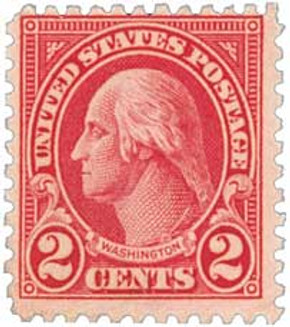
U.S. #638
1926-28 Rotary Stamps
6¢ James A. Garfield
First Day of Issue: July 27, 1927
First City: Washington, D.C.
Printing Method: Rotary Press
Perforation: 11 x 10 ½
Color: Red orange
The portrait of James A. Garfield on this stamp came from an artotype (an early kind of photograph) taken by Edward Bierstadt. (Edward’s brother, Albert, was a famous painter who was later honored on U.S. #4346.) Few photographs were taken of Garfield, as he was shot by an upset office-seeker just four months into his term in office. He died 80 days later, on September 19, 1881.
This Garfield stamp was not commonly used when it was first issued. However, when the first class letter rate changed to 3¢ in 1932, it was commonly used to pay the double-weight letter rate. Its use increased again two years later when the Airmail rate was reduced from 8¢ to 6¢.
Perfecting Perforations on Rotary Stamps
When the Bureau began printing sheets on the rotary press, they found 11 gauge perforations were too fine, causing the stamps to separate prematurely. This resulted in the perforations being changed back to 10 gauge perforations, which had first been used in 1915. Once again, objections were raised, and the Bureau began looking for a way to perforate the stamps so they were strong enough to resist premature separation, yet fine enough to be separated without difficulty. The solution was found in a compromise that resulted in a new perforation – the 10 1/2 gauge.
This perforation seemed to please everyone and was adopted as the new standard for rotary press sheets. In the words of Linn’s author Gary Griffith, the 1926-28 Compound Perforation rotary stamps represent “if not perfection, then at least a high degree of achievement...”













